Introduction
Welcome to the OmniFocus 2 for iOS User Manual!
OmniFocus is the personal task management tool that helps you keep track of all the goals, plans, errands, and aspirations that come up in your life. Now in a universal version you can use on any device with iOS 9, OmniFocus 2 for iOS is even better at helping keep you on top of everything you need to do throughout your day.
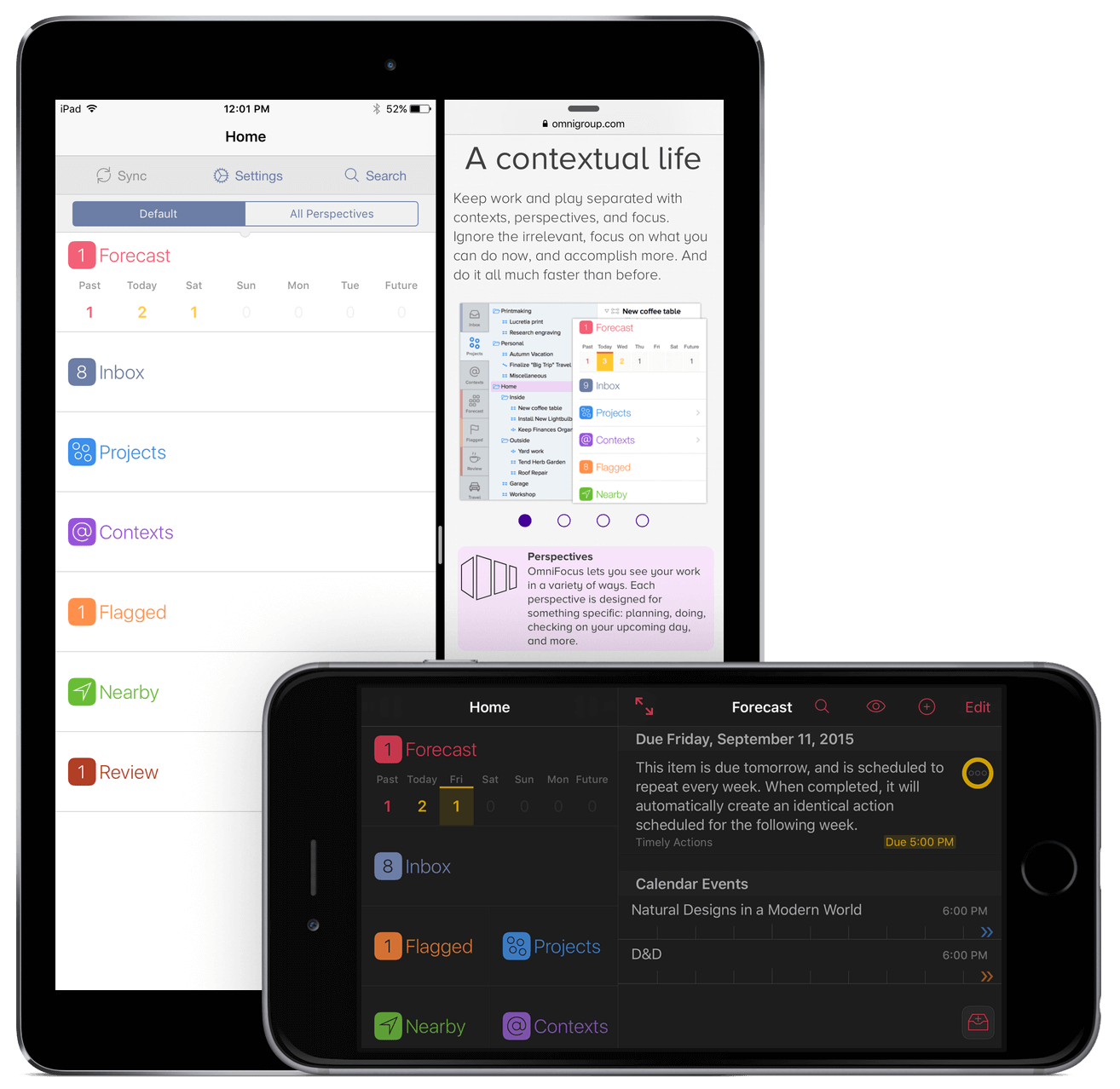
Available on your iPad, iPhone, and Apple Watch (through the OmniFocus for Apple Watch extension), OmniFocus for iOS is packed full of tools to help you prioritize steps within complex projects or simply jot a quick to-do list for a weekly meeting. OmniFocus works great as a standalone productivity aid or in conjunction with whatever time and task-management scheme suits your personal style.
Note
OmniFocus for iOS (the subject of this manual) is available on the App Store, and works on all of your iOS devices as well as your Apple Watch (through the OmniFocus for Apple Watch extension).
OmniFocus for Mac is available both on the Mac App Store and directly from The Omni Group.
OmniFocus for iOS is the mobile counterpart to OmniFocus for Mac, and works seamlessly to bring all the power and versatility of the OmniFocus system to your fingertips. It uses the newest iOS and Apple hardware updates to help you get things done when it's most sensible, convenient, and efficient to do them.
For a video tour of the features of OmniFocus, check out:
https://www.omnigroup.com/video/omnifocus/#omnifocus-2-for-ios
How This Documentation is Organized
This manual that you have before you (online, in iBooks on your Mac or iOS device, or both) has been assembled in such a way that you’re provided with a complete tour of OmniFocus.
We designed this book to help both new and experienced OmniFocus users hit the ground running with the latest version of OmniFocus for your mobile devices. The chapters that follow explain the layout of the app, and then delve into the various perspectives that help you get a handle on the panorama of tasks that fill your day. The manual finishes with ways you can get even more out of OmniFocus, diving inward to the details of scheduling and enriching your tasks, and branching outward to the wide world of interactions OmniFocus has with other apps and platforms you use.
To help guide you through the documentation and better learn all the things you need to know about OmniFocus, here’s a list of all of the chapters in this book:
- Chapter 1, Getting Synced
- Before you start using OmniFocus in earnest it's a good idea to set up a sync account, and this chapter explains how. Even if you only have OmniFocus on one iOS device, syncing is a great way to keep a second copy of your data handy — and if you're running OmniFocus in multiple places, syncing keeps you up to date no matter where you are.
- Chapters 2-4, Guided Tour (iPad, iPhone, iPhone 6/6s Plus)
- After you're all synced up, it's time to start exploring OmniFocus. The Guided Tour chapter for your particular device is the place to earn your OmniFocus navigator's license, acting as your guide from the home screen to the contextual menus throughout the app — a great jumping-off point for further adventures in productivity.
- Chapter 5, Collecting with the Inbox
- The Inbox is the indispensable first point of entry for notes, goals, tasks, and aspirations that come up throughout your day. Whether you're just starting with OmniFocus or a seasoned veteran, adding to, then working through the items in your Inbox is a great way to get started.
- Chapter 6, Planning with Projects
- When a task has multiple moving parts, steps that need completing, or a scope more complex than a one-off shopping trip, organizing multiple simple actions into a project can help you handle even the most daunting of challenges. This chapter covers the various types of projects and how they can be used to most effectively aid your productivity.
- Chapter 7, Organizing with Contexts
- Setting a context for a person, place, or thing needed to move a task along helps you track and complete otherwise unrelated actions when it's most convenient. This chapter delves into the concept of contexts, and shows how OmniFocus can be location-aware with alerts to remind you when you're near a nexus of potential activity.
- Chapter 8, Looking Ahead with Forecast
- If you use OmniFocus for time-sensitive projects, the Forecast perspective is your friend. This chapter helps you ground your OmniFocus experience among everything else happening in a busy week, and guides you through integration of your external Calendars with OmniFocus.
- Chapter 9, Prioritizing with Flags
- The Flagged perspective offers another way to mark important projects and actions. By design the exact meaning of "flagged" isn't defined, so you can use it for whatever you like — and this chapter explains how flagging items works.
- Chapter 10, Taking Action Nearby
- If you've set up location information for a context, the Nearby perspective provides a look at the context — and its associated actions — based on physical proximity. This chapter describes how to use the Map and List views to get stuff done, geographically.
- Chapter 11, Updating Project Status with Review
- After you've been using OmniFocus for awhile you may find that you've accumulated a daunting list of tasks. This chapter helps you set up regular reviews of your work in progress to keep the most important projects on track.
- Chapter 12, Working with Perspectives
- There's a whole lot you can do with the default perspectives included with OmniFocus. With custom perspectives, views on your projects and contexts become infinite — this chapter delves into the ways you can use the OmniFocus Pro upgrade to customize OmniFocus to suit your exact needs.
- Chapter 13, Using Notes and Attachments
- Adding custom data to actions and projects is a great way to ensure they fully and accurately describe your goals. This chapter helps make sure your vision is realized through attached images, sounds, and text.
- Chapter 14, Using Dates and Times
- OmniFocus is all about things you need to do in the gaps between events scheduled on your calendar. How you express when projects and actions become available for work, are due, and (possibly) recur is important, and this chapter dives into the details of how OmniFocus items can be grounded in time.
- Chapter 15, OmniFocus Extended
- While it works great as a standalone app on your device, OmniFocus can be so much more. This chapter describes how you can integrate OmniFocus into your broader workflow, working with email, Siri, the Calendar app, iOS 9 extensions, and more.
- Chapter 16, OmniFocus Settings
- This chapter describes the various configuration options available in OmniFocus Settings.
- Chapter 17, Glossary
- This chapter provides an alphabetical list of terminology associated with OmniFocus. If you see a word used in this manual that you can't puzzle out, it's (hopefully) included here.
- Chapter 18, Keyboard Shortcuts
- If you're using OmniFocus for iOS with an external keyboard connected to your device, you can take advantage of the app's built-in keyboard shortcuts. This chapter provides a list of the available shortcuts based on where you are and what you're doing in OmniFocus.
- Chapter 19, Getting Help
- Finally, if there's something OmniFocus-related you're having trouble with — anything at all — this chapter contains resources for finding a solution.
Using This Book
One of the beauties of having OmniFocus's documentation available in electronic form is that it's always available whenever you need it. We have put all of the documentation on our website where it can be searched and bookmarked. We're also continuing to create EPUB versions of the documentation that are freely available on the iBooks Store.
What's New in OmniFocus 2.9 for iOS
OmniFocus 2.9 for iOS introduces keyboard shortcuts for use with Bluetooth or other keyboards connected to any iPad with OmniFocus. Press and hold the Command key on your keyboard to view a list of shortcuts applicable to your current location in the app.
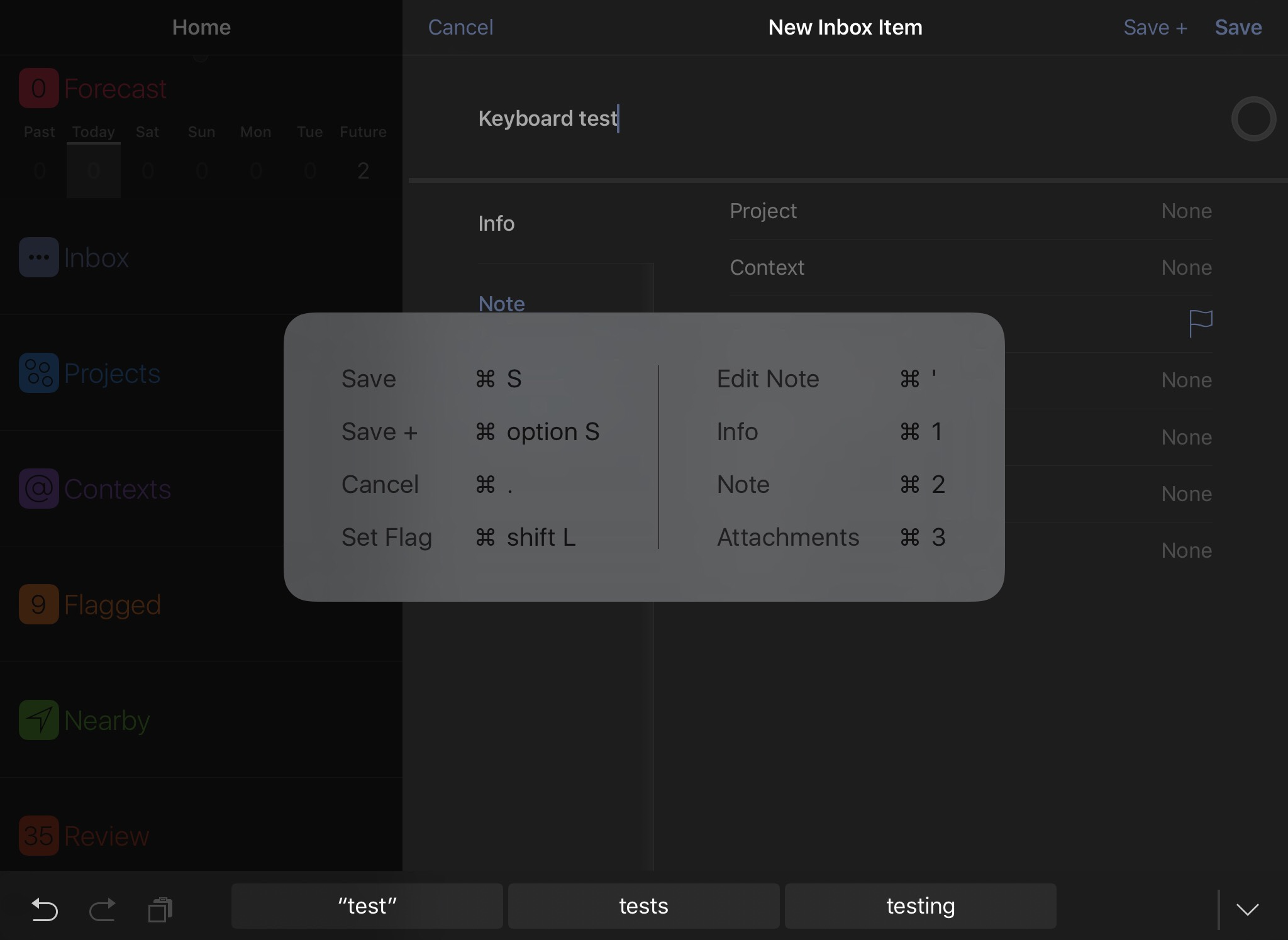
In addition to the keyboard shortcuts new in version 2.9, recent OmniFocus updates include several other features that take advantage of new technologies in iOS 9. On devices that support it, 3D touch is available from the OmniFocus app icon on the iOS home screen — you can launch straight into the perspective most important to you, or begin creating a new inbox item right away.
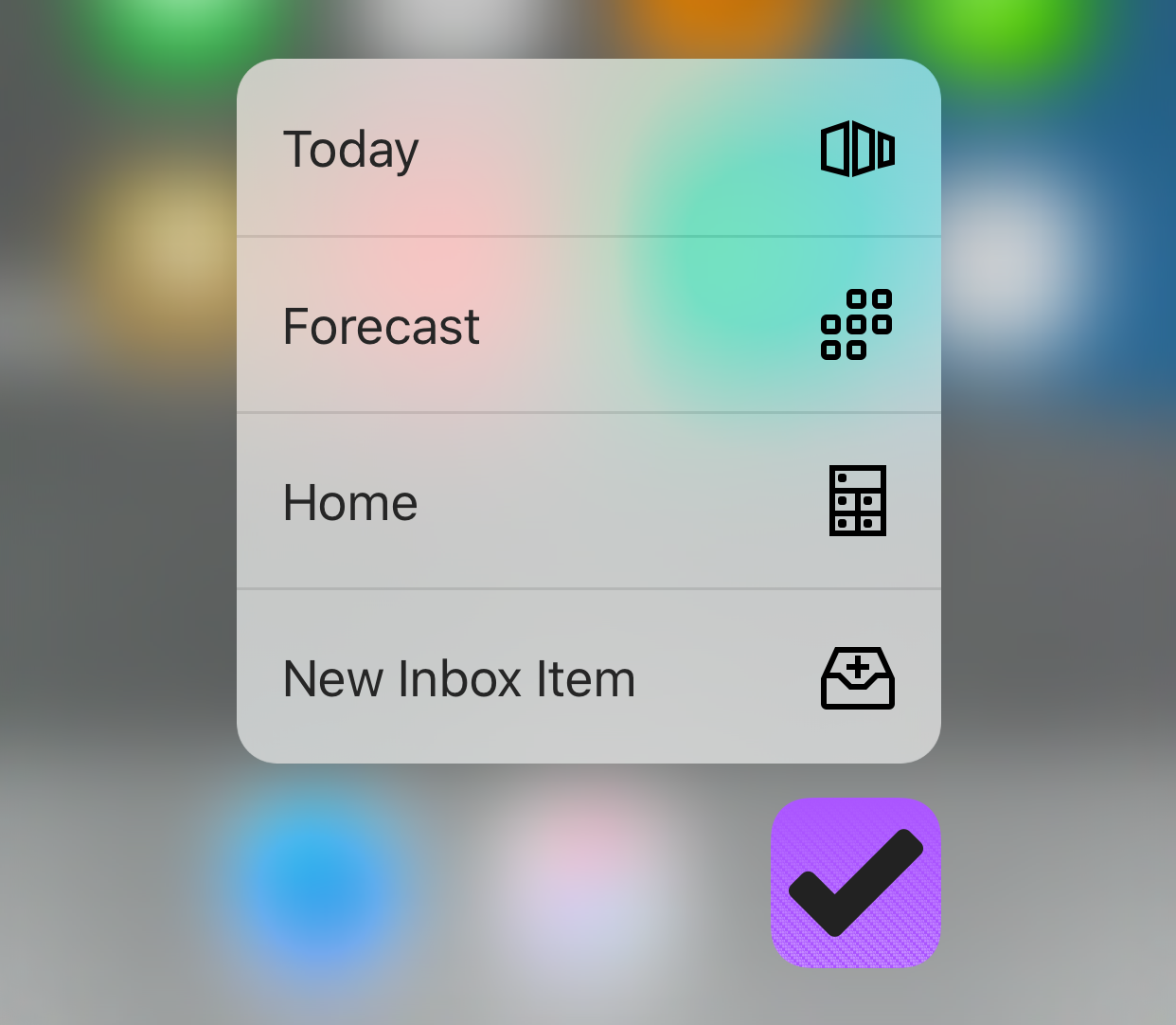
OmniFocus items — including contexts, folders, and perspectives — are also now discoverable through the updated Spotlight Search function (drag down on the center of the iOS home screen to reveal it), and if you're using OmniFocus on a device that supports it, you can take advantage of Split View to multitask like never before.
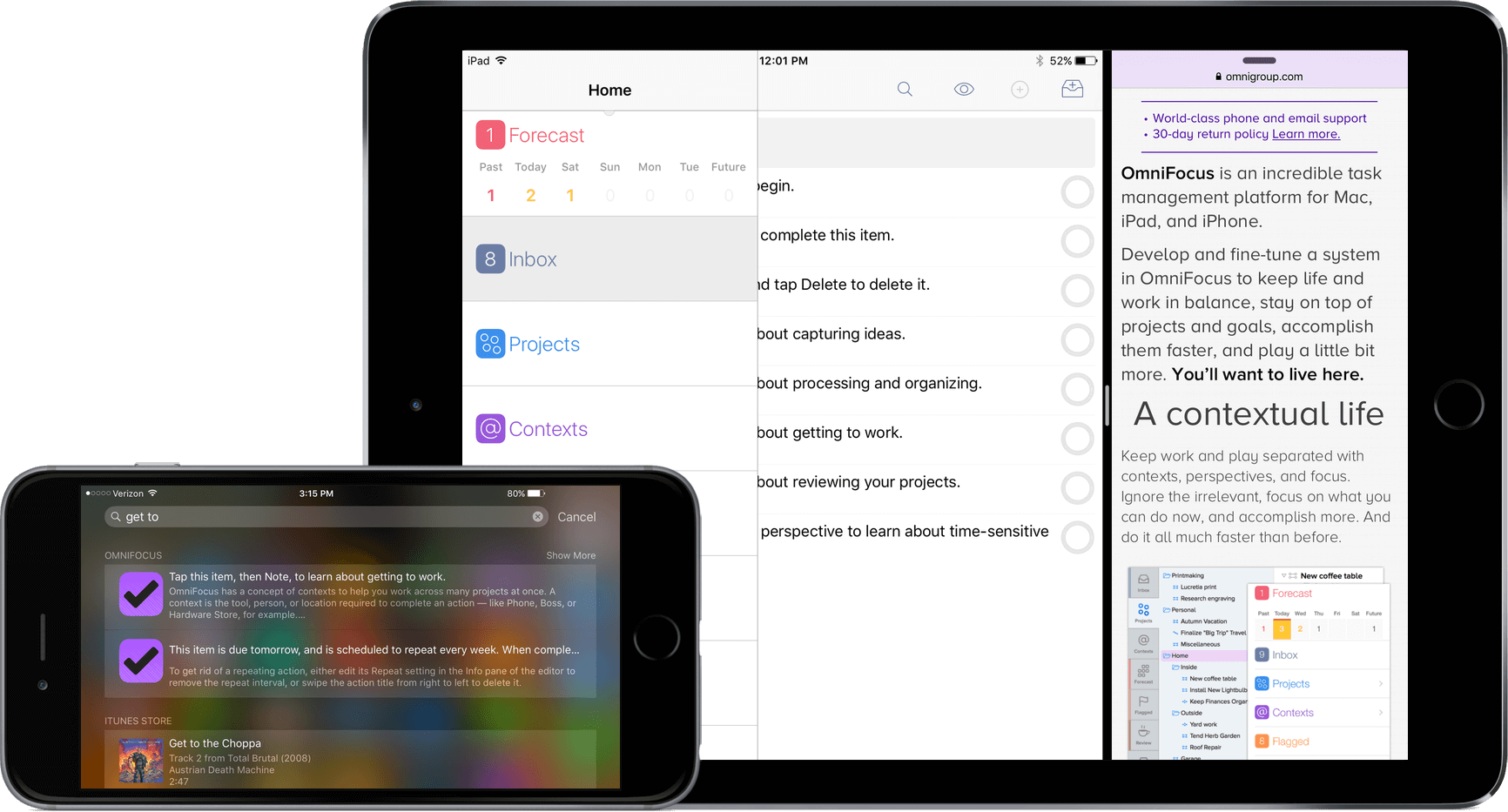
We've also updated the OmniFocus for Apple Watch extension to run natively on the brand-new watchOS 2 (a free update with iOS 9). What this means is more view flexibility, more customization, and last but not least — the addition of an OmniFocus complication that you can add to your Apple Watch face to get an even more convenient summary of your day.
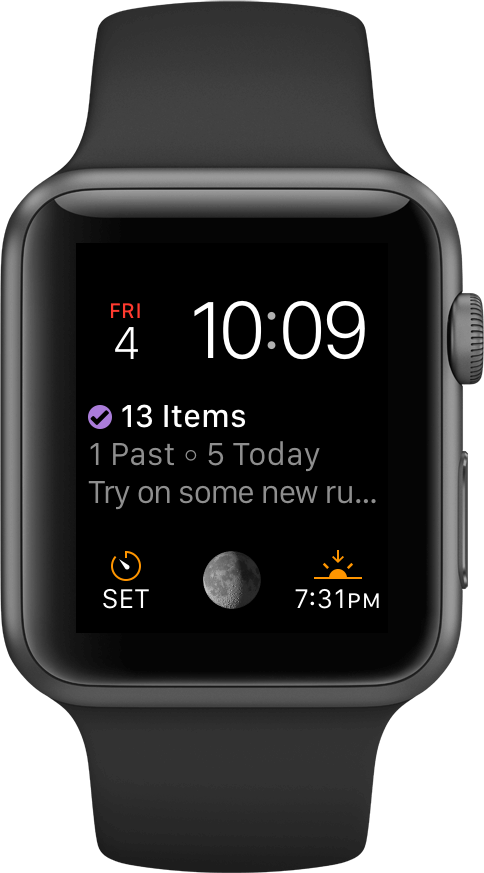
If you're new to OmniFocus for Apple Watch, or would like a more detailed look at the updated features for watchOS 2, we've prepared this support article on the Omni website just for you.
Note
One additional change in iOS 9 that affects OmniFocus is the behavior of Reminders Capture. Siri's capabilities have been expanded, but the access OmniFocus is granted to them has not. You won't lose anything by capturing with Siri — we're committed to full preservation of your data — but if you use Siri to capture reminders into OmniFocus you'll want to check the Reminders Capture section of the manual for more information.
Making the Transition
If you've been using an earlier version of OmniFocus or have OmniFocus on another device, getting up to speed with OmniFocus for iOS is a breeze.
Migrating your Database
Syncing OmniFocus 2 for iOS to your existing OmniFocus database in the cloud is the recommended method for migrating from other versions, including earlier versions of OmniFocus for iOS. It provides a straightforward pathway for keeping your data up to date, and keeps all versions of OmniFocus playing nicely together if you're running the app on multiple devices.
Tip
Confused about the sync setup process? Check out Getting Synced for a refresher.
While it's not recommended, if you choose not to sync the first time you launch the app you'll have the option set up sync later from the in-app Settings; remember that any changes you make locally can't be merged with your remote database, so setting up sync when you first open OmniFocus is the best way to be sure your data is preserved.
Interface Improvements in OmniFocus 2
If you're completely new to OmniFocus 2, you might want to take a few minutes to get up to speed with recent improvements to the interface that we've adopted across the OmniFocus family to make the apps even more powerful and easy to use.
Summary Dots — These handy bits represent an overview of the amount and priority of items within a project or context, giving you an at-a-glance estimate of the size and urgency of things relative to other things.

Status Circles — Checkboxes for marking items complete have been replaced by status circles. Still great for checking things off when they're finished, status circles also convey the status of an item at a glance: whether it's due soon (amber), overdue (red), or flagged (orange). Repeating items are also distinct by virtue of the elipses in their center – when you see them, you know they'll keep coming back for more.
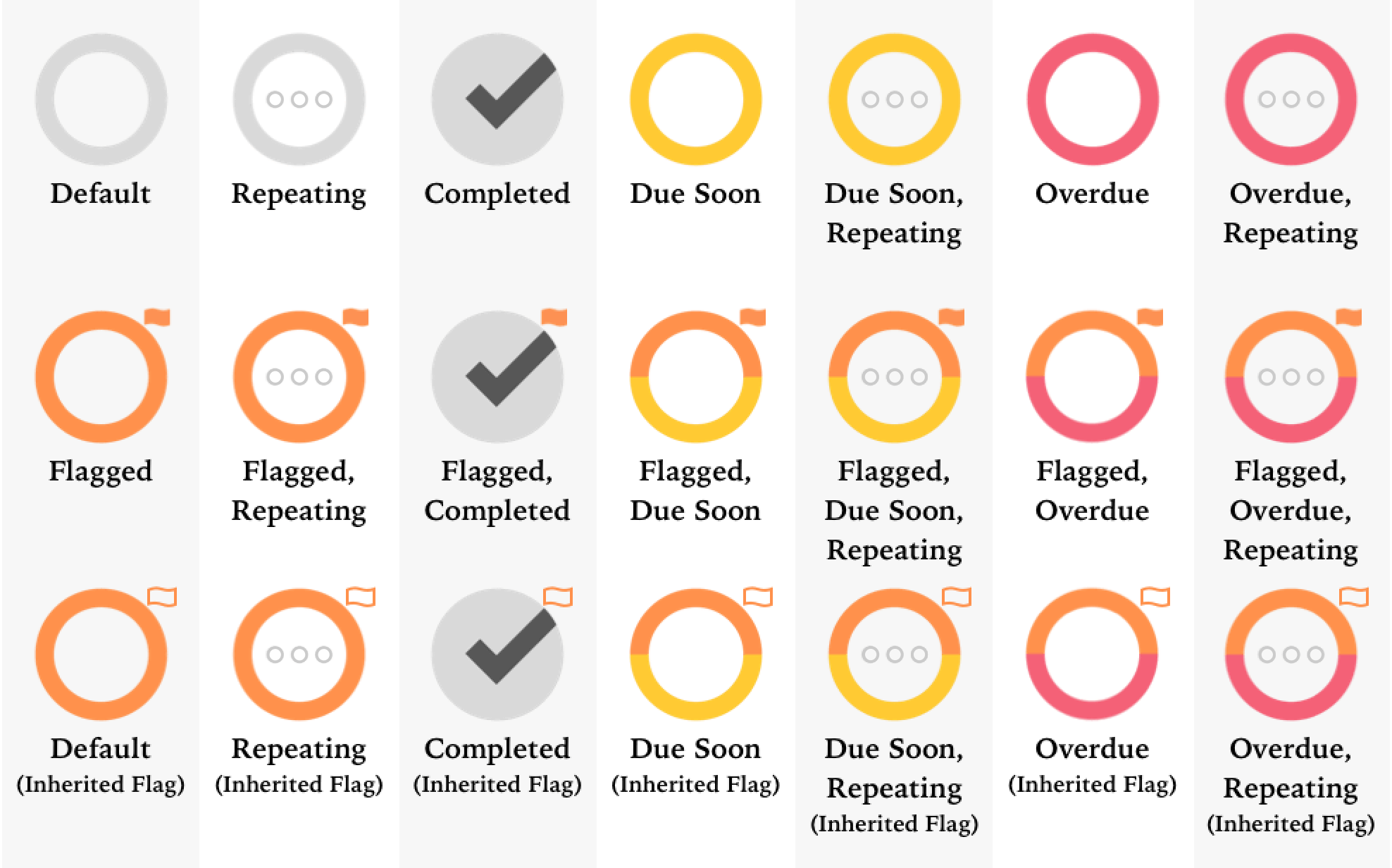
Got an action that’s more than one status, like flagged and overdue? The circle will take on multiple status colors simultaneously—half orange on top, half red on bottom—to communicate everything that's going on. Likewise, an item that's nested inside a flagged project or group will inherit the flagged property; when a flag is inherited, its icon is hollow rather than filled.
Secret Bar — Drag down on the sidebar or home screen to reveal the secret bar, where the Sync, Settings, and Search buttons are safely tucked away.
Toggle between lists of all available perspectives and just your favorite ones (and with the Pro upgrade installed, you'll create new perspectives and edit the tiled layout of your home screen here, too).
Changing Terminology
To help better represent their function, a few things have changed about how OmniFocus 2 describes certain features of the app.
Start dates are now defer dates. This is to more accurately capture the intent that an item shouldn't be considered until a later time—it's been deferred.
Next actions are now first available actions. This helps explain view options more clearly, and helps further disambiguate sequential projects, parallel projects, and single action lists.
Project and Context-based perspectives have become Use Project Hierarchy and Don't Use Project Hierarchy, respectively. This is to better reflect the role this choice plays in affecting other aspects of a custom perspective's view settings.
Since the act of “focusing” has such a specific meaning in OmniFocus, the Focus command in contextual menus has been replaced with the more accurate Go To Project and Go to Context. Its functionality remains the same.
Note
On iPad or iPhone 6/6s Plus (in landscape orientation), if you've delved in to view a subset of your items in the Project or Context perspectives (perhaps via Go to Project or Go to Context), you can quickly ascend to the perspective's top level by tapping its name in the toolbar or sidebar header.
